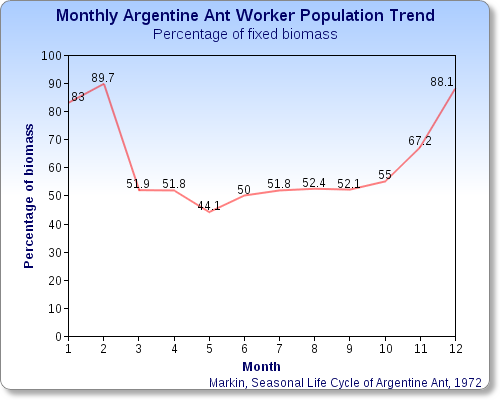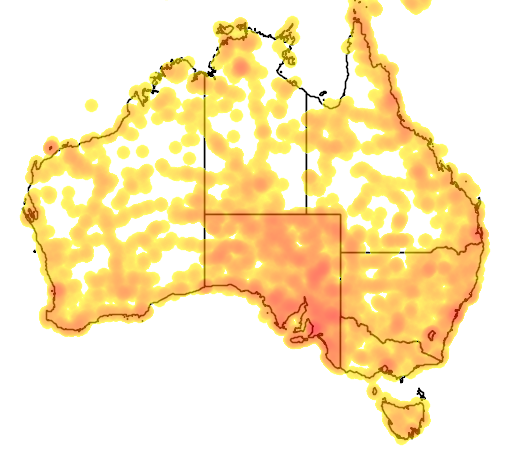|
Supercolony
An ant supercolony is an exceptionally large ant colony, consisting of a high number of spatially separated but socially connected nests of a single ant species (meaning that the colony is polydomous), spread over a large area without territorial borders. Supercolonies are typically polygynous, containing many egg-laying females (queens or gynes).''Supercolonies.'' AntWiki (July 2022 accessed)''Outnumbered: a new dominant ant species with genetically diverse supercolonies in Ethiopia'' D.M. ... [...More Info...] [...Related Items...] OR: [Wikipedia] [Google] [Baidu] |
Ant Colony
An ant colony is a population of a single ant species capable to maintain its complete lifecycle. Ant colonies are eusocial, communal, and efficiently organized and are very much like those found in other social Hymenoptera, though the various groups of these developed sociality independently through convergent evolution. The typical colony consists of one or more egg-laying queens, numerous sterile females (workers, soldiers) and, seasonally, many winged sexual males and females. In order to establish new colonies, ants undertake flights that occur at species-characteristic times of the day. Swarms of the winged sexuals (known as alates) depart the nest in search of other nests. The males die shortly thereafter, along with most of the females. A small percentage of the females survive to initiate new nests. Names The term "ant colony" refers to a population of workers, reproductive individuals, and brood that live together, cooperate, and treat one another non-aggressively. ... [...More Info...] [...Related Items...] OR: [Wikipedia] [Google] [Baidu] |
Argentine Ant
The Argentine ant (''Linepithema humile''), formerly ''Iridomyrmex humilis'', is an ant native to northern Argentina, Uruguay, Paraguay, Bolivia and southern Brazil. It is an invasive species that has been established in many Mediterranean climate areas, inadvertently introduced by humans to many places, including South Africa, New Zealand, Japan, Easter Island, Australia, Europe, Hawaii, and the continental United States. Description The worker ants are long and can easily squeeze through cracks and holes as small as in size. Queens are long, much smaller than other species of ants. These ants will set up quarters in the ground, in cracks in concrete walls, in spaces between boards and timbers, even among belongings in human dwellings. In natural areas, they generally nest shallowly in loose leaf litter or beneath small stones, due to their poor ability to dig deeper nests. However, if a deeper nesting ant species abandons their nest, Argentine ant colonies will readily ... [...More Info...] [...Related Items...] OR: [Wikipedia] [Google] [Baidu] |
Linepithema Humile
The Argentine ant (''Linepithema humile''), formerly ''Iridomyrmex humilis'', is an ant native to northern Argentina, Uruguay, Paraguay, Bolivia and southern Brazil. It is an invasive species that has been established in many Mediterranean climate areas, inadvertently introduced by humans to many places, including South Africa, New Zealand, Japan, Easter Island, Australia, Europe, Hawaii, and the continental United States. Description The worker ants are long and can easily squeeze through cracks and holes as small as in size. Queens are long, much smaller than other species of ants. These ants will set up quarters in the ground, in cracks in concrete walls, in spaces between boards and timbers, even among belongings in human dwellings. In natural areas, they generally nest shallowly in loose leaf litter or beneath small stones, due to their poor ability to dig deeper nests. However, if a deeper nesting ant species abandons their nest, Argentine ant colonies will readily take ... [...More Info...] [...Related Items...] OR: [Wikipedia] [Google] [Baidu] |
Formica Obscuripes
''Formica obscuripes'' (western thatching ant) is a species of ant in the family Formicidae. It is native to North America. It produces large mounds covered by small pieces of plant material. The number of adult workers per colony may be as high as 40,000. ''F. obscuripes'' feeds upon a number of insect species, consumes nectar from homopterous insects they tend, and occasionally eats plant tissue. Nests ''F. obscuripes'' creates distinct, dome-shaped mounds composed of varying materials found in the nest's surrounding environment. This composition is primarily vegetation and is commonly called "thatch". The mounds are typically constructed in areas devoid of cover to expose the nest to sunlight. The size of these mounds is highly variable and is mostly determined by the age and health of the colony. The height ranges from 1 to 18 inches (15–45 cm), although nests of larger heights are not uncommon, and can extend down to 4 ft (1.2 m) in the ground, with chambe ... [...More Info...] [...Related Items...] OR: [Wikipedia] [Google] [Baidu] |
Lasius Neglectus
''Lasius neglectus'' is a polygynous, sometimes invasive, ant of the genus ''Lasius''. The ant was identified in 1990 after establishing a colony in Budapest, Hungary. Superficially, they are similar in appearance to the common black garden ant, ''Lasius niger'', but have significantly different behavioural patterns, particularly in the social structure within colonies. ''Lasius neglectus'' is believed to be prey for several animals and insects, specifically ''Clytra laeviuscula'' and some Picidae family birds. Colonies ''Lasius neglectus'' occupies 'super colonies', systems of interconnected nests with many queens, estimated to be over 35,500 in some colonies. The queens, instead of moving to a new nest to start a new colony, will mate within the existing colony. Unlike most ant species, queens mate underground and are incapable of flight. As the occupants of these colonies are related, they do not demonstrate territorial aggression. ''Lasius neglectus'' does not build elaborat ... [...More Info...] [...Related Items...] OR: [Wikipedia] [Google] [Baidu] |
Mating Flight
Nuptial flight is an important phase in the reproduction of most ant, termite, and some bee species. It is also observed in some fly species, such as ''Rhamphomyia longicauda''. During the flight, virgin queens mate with males and then land to start a new colony, or, in the case of honey bees, continue the succession of an existing hived colony. The winged version of ants and termites are known as alates. Before the flight A mature ant colony seasonally produces winged virgin queens and males, called alates. Unfertilized eggs develop into males. Fertilized eggs usually develop into wingless, sterile workers, but may develop into virgin queens if the larvae receive special attention. Within a few days after they have emerged (eclosed) from the pupa case, males are "quickly converted into single-purpose sexual missiles." Young queens and males stay in their parent colony until conditions are right for the nuptial flight. The flight requires clear weather since rain is dis ... [...More Info...] [...Related Items...] OR: [Wikipedia] [Google] [Baidu] |
Formica Exsecta
''Formica exsecta'' (the narrow-headed ant or excised wood ant) is a species of ant found from Western Europe to Asia. A rare formicine ant with a deeply excised head, ''F. exsecta'' forms small mounds up to around a foot in height consisting of much finer material than that used by "true" wood ants of the ''F. rufa'' group. An interesting feature of ''F. exsecta'' is that it occurs in two distinct social forms: either a monogyne form where the colony has a single egg-laying queen, or a polygyne form where many egg-laying queens are part of the same colony. ''F. exsecta'' is placed in the ''Coptoformica'' subgenus within the genus and is closely related to '' Formica exsectoides'', an American species. Both species may form vast colony networks. The largest known polydomous system of ''F. exsecta'' consists of 3,350 nests dispersed over about 22 ha in Transylvania, Romania. In Great Britain, ''F. exsecta'' can be found only in a few scattered heathland locations in South Wes ... [...More Info...] [...Related Items...] OR: [Wikipedia] [Google] [Baidu] |
Formica Polyctena
''Formica polyctena'' is a species of European red wood ant in the genus ''Formica'' and large family Formicidae. The species was first described by Arnold Förster in 1850. The latin species name ''polyctena'' is from Greek and literally means 'many cattle', referring to the species' habit of farming aphids for honeydew food. It is found in many European countries. It is a eusocial species, that has a distinct caste system of sterile workers and a very small reproductive caste. The ants have a genetic based cue that allow them to identify which other ants are members of their nest and which are foreign individuals. When facing these types of foreign invaders the ''F. polyctena'' has a system to activate an alarm. It can release pheromones which can trigger an alarm response in other nearby ants. It is found in Austria, Belgium, Bulgaria, Czech Republic, Estonia, Finland, France, Germany, Hungary, Italy, Latvia, Lithuania, Luxembourg, the Netherlands, Norway, Poland, Romania, ... [...More Info...] [...Related Items...] OR: [Wikipedia] [Google] [Baidu] |
Formica Yessensis
''Formica yessensis'' is a species of ant in the genus ''Formica'', being known from eastern Asia and Japan. This species is especially known for its large colonies In modern parlance, a colony is a territory subject to a form of foreign rule. Though dominated by the foreign colonizers, colonies remain separate from the administration of the original country of the colonizers, the '' metropolitan state'' ..., sometimes exceeding 300 million individuals. The workers are typically 8-10 mm in length. References External links * yessensis Hymenoptera of Asia Insects described in 1913 {{formicinae-stub ... [...More Info...] [...Related Items...] OR: [Wikipedia] [Google] [Baidu] |
Iridomyrmex Purpureus
''Iridomyrmex'' is a genus of ants called rainbow ants (referring to their blue-green iridescent sheen) first described by Austrian entomologist Gustav Mayr in 1862. He placed the genus in the subfamily Dolichoderinae of the family Formicidae. It has 79 described species and five fossil species. Most of these ants are native to Australia; others are found in Asia and Oceania, and they have been introduced to Brazil, New Zealand, and the United Arab Emirates. Fossil species are known from China, France, and the United States. These ants are known to be an ecologically dominant and important group of ants, but they are sometimes regarded as pests because they disturb soil and enter human houses. Farmers in rural Australia place animal carcasses on meat ant ('' I. purpureus'') mounds as a method of disposing of them; meat ants consume the carcass and reduce it to bones in a matter of weeks. Meat ants also engage in ritualised fighting, which helps prevent casualties and solve te ... [...More Info...] [...Related Items...] OR: [Wikipedia] [Google] [Baidu] |
Lepisiota
''Lepisiota'' is an Old World genus of ants in the subfamily Formicinae. They nest in rotten wood, in standing trees or in the ground, generally in less forested areas. Species *''Lepisiota acuta'' Xu, 1994 *''Lepisiota affinis'' (Santschi, 1937) *''Lepisiota ajjer'' (Bernard, 1953) *'' Lepisiota albata'' (Santschi, 1935) *''Lepisiota alexis'' (Santschi, 1937) *''Lepisiota ambigua'' (Santschi, 1935) *''Lepisiota angolensis'' (Santschi, 1937) *''Lepisiota annandalei'' (Mukerjee, 1930) *''Lepisiota arabica'' (Collingwood, 1985) *''Lepisiota arenaria'' (Arnold, 1920) *''Lepisiota arnoldi'' (Forel, 1913) *''Lepisiota aurea'' (Karavaiev, 1933) *''Lepisiota bipartita'' (Smith, 1861) *''Lepisiota cacozela'' (Stitz, 1916) *''Lepisiota canescens'' (Emery, 1897) *''Lepisiota capensis'' (Mayr, 1862) *''Lepisiota capitata'' (Forel, 1913) *'' Lepisiota carbonaria'' (Emery, 1892) *'' Lepisiota chapmani'' (Wheeler, 1935) *'' Lepisiota crinita'' (Mayr, 1895) *'' Lepisiota curta'' (Emery, 1897) ... [...More Info...] [...Related Items...] OR: [Wikipedia] [Google] [Baidu] |





.jpg)
